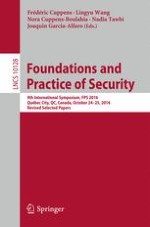2017 | OriginalPaper | Buchkapitel
On the Feasibility of Malware Authorship Attribution
verfasst von : Saed Alrabaee, Paria Shirani, Mourad Debbabi, Lingyu Wang
Erschienen in: Foundations and Practice of Security
Aktivieren Sie unsere intelligente Suche, um passende Fachinhalte oder Patente zu finden.
Wählen Sie Textabschnitte aus um mit Künstlicher Intelligenz passenden Patente zu finden. powered by
Markieren Sie Textabschnitte, um KI-gestützt weitere passende Inhalte zu finden. powered by
